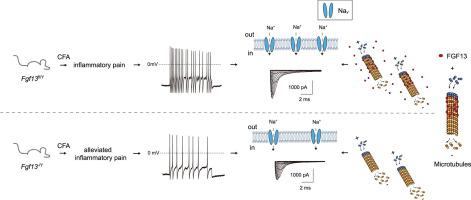Journal of Advanced Research ( IF 11.4 ) Pub Date : 2020-12-17 , DOI: 10.1016/j.jare.2020.12.009 Qiong Wang 1 , Jing Yang 2 , Handong Wang 3 , Bin Shan 4 , Chengyu Yin 5 , Hang Yu 3 , Xuerou Zhang 3 , Zishan Dong 1 , Yulou Yu 1 , Ran Zhao 1 , Boyi Liu 5 , Hailin Zhang 1 , Chuan Wang 1

|
Introduction
Fibroblast growth factor homologous factors (FHFs), among other fibroblast growth factors, are increasingly found to be important regulators of ion channel functions. Although FHFs have been link to several neuronal diseases and arrhythmia, its role in inflammatory pain still remains unclear.
Objectives
This study aimed to investigate the role and mechanism of FGF13 in inflammatory pain.
Methods
Fgf13 conditional knockout mice were generated and CFA-induced chronic inflammatory pain model was established to measure the pain threshold. Immunostaining, western blot and quantitative real-time reverse transcription PCR (qRT-PCR) were performed to detect the expression of FGF13 in CFA-induced inflammatory pain. Whole-cell patch clamp recording was used to record the action potential firing properties and sodium currents of DRG neurons.
Results
Conditional knockout of Fgf13 in dorsal root ganglion (DRG) neurons (Fgf13-/Y) led to attenuated pain responses induced by complete Freund's adjuvant (CFA). FGF13 was expressed predominantly in small-diameter DRG neurons. CFA treatment resulted in an increased expression of FGF13 proteins as well as an increased excitability in nociceptive DRG neurons which was inhibited when FGF13 was absent. The role of FGF13 in neuronal excitability of DRG was linked to its modulation of voltage-gated Na+ channels mediated by microtubules. Overexpression of FGF13, but not FGF13 mutant which lacks the ability to bind and stabilize microtubules, rescued the decreased neuronal excitability and Na+ current density in DRG neurons of Fgf13-/Y mice.
Conclusion
This study revealed that FGF13 could stabilize microtubules to modulate sodium channel function in DRG neurons and modulate inflammatory pain. This study provides a novel mechanism for FGF13 modulation of sodium channel function and suggests that FGF13 might be a novel target for inflammatory pain treatment.
中文翻译:

成纤维细胞生长因子 13 稳定微管以促进伤害性背根神经节神经元中的 Na+ 通道功能并调节炎症性疼痛
介绍
越来越多地发现成纤维细胞生长因子同源因子 (FHF) 以及其他成纤维细胞生长因子是离子通道功能的重要调节剂。尽管 FHF 与多种神经元疾病和心律失常有关,但其在炎症性疼痛中的作用仍不清楚。
目标
本研究旨在探讨 FGF13 在炎症性疼痛中的作用和机制。
方法
产生Fgf13条件性基因敲除小鼠,建立CFA诱导的慢性炎症性疼痛模型测量痛阈。进行免疫染色、蛋白质印迹和定量实时逆转录 PCR (qRT-PCR) 以检测 FGF13 在 CFA 诱导的炎症性疼痛中的表达。全细胞膜片钳记录用于记录 DRG 神经元的动作电位放电特性和钠电流。
结果
背根神经节 (DRG) 神经元 ( Fgf13 -/Y )中Fgf13 的条件性敲除导致完全弗氏佐剂 (CFA) 诱导的疼痛反应减弱。FGF13 主要在小直径 DRG 神经元中表达。CFA 治疗导致 FGF13 蛋白的表达增加以及伤害性背根神经节神经元的兴奋性增加,当 FGF13 不存在时,该神经元受到抑制。FGF13 在 DRG 神经元兴奋性中的作用与其对微管介导的电压门控 Na +通道的调节有关。FGF13 的过表达,而不是缺乏结合和稳定微管能力的 FGF13 突变体,挽救了DRG 神经元中降低的神经元兴奋性和 Na +电流密度Fgf13 -/Y小鼠。
结论
该研究表明,FGF13 可以稳定微管以调节 DRG 神经元中的钠通道功能并调节炎症性疼痛。该研究为 FGF13 调节钠通道功能提供了一种新机制,并表明 FGF13 可能是治疗炎症性疼痛的新靶点。











































 京公网安备 11010802027423号
京公网安备 11010802027423号